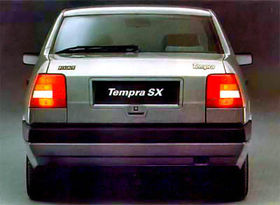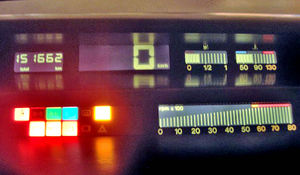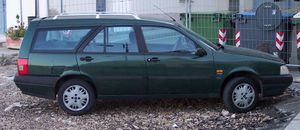Fiat Tempra

| |
| Fiat Tempra | |
|---|---|
| Manufacturer: | Fiat |
| Production: | 1990—1995 |
| Layout & Class: | FF mid-size |
| Body Styles: | sedan station wagon |
| Predecessor: | Fiat Regata |
| Successor: | Fiat Marea |
| Similar to: | Alfa Romeo 155 Fiat Tipo Lancia Dedra |

| |
The Fiat Tempra is a medium family car produced by Italian automaker Fiat from 1990 to 1998. The Tempra was intended as a replacement for the Fiat Regata. The original poject was called Tipo 3, being a mid-size car between the Fiat Tipo (project Tipo 2) and the bigger Fiat Croma (project Tipo 4). The Tempra shares its platform with the Lancia Dedra and Alfa Romeo 155.
Overview
The Tempra saloon was introduced in February 1990 with the station wagon arriving later in the year. The initial engine range comprised 1.4, 1.6 and 1.8 petrol units and normally aspirated and turbocharged 1.9-litre diesel units.
Mechanics
The Tempra's engine range was similar to that of the Tipo. Initially 1.4 and 1.6-litre models had carburettor engines. Both of these models were discontinued in 1992 due to the new European emission standardsand thus all models from 1992 on had catalytic converters and electronic injection. Transmission was a standard 5 speed manual , but for the first time a mid size sedan was offered as with a continuously variable transmission already tested on Fiat Uno, Panda, Ritmo and Tipo. 2.0-litre-models were also available with an optional 4-speed automatic transmission.
During the its 6 year production run few changes were made apart from a minor facelift in 1993 resulting in a new front grille and other minor styling changes.
Chassis and main parts (most notably, the doors) were shared with the Fiat Tipo. Other vehicles, derived from the same project were Lancia Dedra (Tempra's most similar cousin, sharing all the mechanical components), Lancia Delta second generation, Alfa Romeo 155, Alfa 145 and Alfa 146.
Equipment and trim levels
Only two trim levels were available in its early years: standard and SX, both reasonably equipped considering its cheap price
SX models for example, featured power windows, power locks, adjustable belts and steering wheel, front fog lights, body coloured bumpers, velvet upholstery, a futuristic digital dashboard and many other standard extras.There were also available interesting optional extras like anti-lock brakes, aluminium wheels, sunroof, electronic climate control, etc
1993 facelift featured more trim levels from standard L models (only available with 1.4 engine) S, SX and SLX only available with 1.8 and 2.0 litre engines.An optional driver's airbag was another innovation that year
Reports
Quattroruote, the most important Italian cars magazine, reported damages and defects of the cars in the market. These informations were useful for everyone who wanted to buy a car, and for automakers also, so they could find assembly line mistakes to improve their vehicles and give a better product.
About Tempra, few damages of series were reported, but some defects that followed the car during its lifetime. First to be reported was a small water infiltration through the windshield gasket, plague that had once involved other Fiat's vehicle, especially Alfa 33, which in rainy condition used to carry a worrying quantity of water on board. Tempra's case was reported from 1990–92 and was solved with a higher quantity of glue in the assembling, and in fact the problem totally disappeared.
Another reported problem was a high oil consumption, especially the 1581 cc engine, which was a common defect with Tipo (with the same engine) and Panda (1000 FIRE engine). The same was reported for other Fiat's vehicles, and seemed to disappear with the new 1.6 l 66 kW engine.
On the same model, from 1994, the car started to show some electronic malfunctions, such as the electronic control unit, code key and electric system, probably caused by some components insufficiently tested, which were not totally compatible with a model projected at the end of the 1980s. A small defect, not technical, only in practical use, on sedan version the rear window was too small and inclined and the tail too tall, so that it was tough to see behind in rear manoeuvres. This particular fact was common to 155 and Dedra, and was one of the reason for the "Station Wagon" had more success than the saloon.
Qualities
Since the beginning, Tempra was presented as a cheap and reliable car. 1372 and 1581 were able to run long distances with a low fuel consumption, also aided by a high capacious tank of 65 L for sedan and 70 L for Station Wagon. Average autonomy for a 1.6 55 kW sedan was around 920 km (14 km/l), and consumption at constant speed was of 16,5 km/l at 90 km/h and 11,6 at 130 km/h. All these were aided by a favorable aerodynamic (Cx 0,297) and only 17,2 PS subtracted at 100 km/h, which was the best result among all the rivals.
Other qualities were the strength and reliability, because the engine could be used in urban drive, extra-urban and highways without worryies, making Tempra a vehicle close to a family that left for holidays, with the trunk full of luggages, or anybody who drove through traffic jam facing queues or traffic lights. For its extraordinary load capacity, it was one of the companies favourites (the 1929 diesel engine), because they could exploit it in every working situations. Besides, there was Marengo's version (a title also used before with the Regata and later the Marea), that represented the commercial version of Tempra, with no rear seats and registered as a truck. Last in order, maintenance was cheap for the easy availability of replacement parts, making reparations and regular check-up simple and not costly.
End of production
The Tempra was discontinued in Europe in 1996, and in Brazil in 1998. It was replaced by the Fiat Marea, which shares some parts with the Fiat Bravo and Fiat Brava, both of which are descendants of Fiat Tipo.
In Brazil 204,795 Tempras were produced, and in Turkey, where the car was manufactured by Tofas, 129,590 were made.
Engines
| Model | Engine | Displacement | Power | Torque | Notes |
|---|---|---|---|---|---|
| 1.4 S | I4 SOHC | 1372 cc | 55 kW (75 PS) | carburator | |
| 1.4 i.e. | I4 SOHC | 1372 cc | 51 kW (69 PS) @6000 rpm | 125 Nm @3000 rpm | cat and fuel injection |
| 1.6 S | I4 SOHC | 1581 cc | 64 kW (86 PS) @6000 rpm | 128 Nm @3000 rpm | carburator |
| 1.6 i.e. | I4 SOHC | 1581 cc | 55 kW (75 PS) @6000 rpm | 128 Nm @3000 rpm | cat and fuel injection |
| 1.6 i.e. | I4 SOHC | 1581 cc | 66 kW (90 PS) @5750 rpm | 127 Nm @2750 rpm | cat and fuel injection |
| 1.8 i.e. | I4 DOHC | 1756 cc | 80 kW (109 PS) | cat and fuel injection | |
| 1.8 i.e. | I4 DOHC | 1756 cc | 77 kW (105 PS) | cat and fuel injection, 1992– | |
| 2.0 i.e. | I4 8V DOHC | 1995 cc | 83 kW (113 PS) @5750 rpm | 156 Nm @3300 rpm | cat and fuel injection |
| 2.0 i.e. | I4 16V DOHC | 1995 cc | 93 kW (127 PS) | Brasil | |
| 2.0 i.e. Turbo | I4 8V DOHC | 1995 cc | 121 kW (165 PS) | (1994-1996 2-door and 1995-1998 4-door Tempra Turbo Stile) Brazilian model | |
| 1.9 D | I4 SOHC | 1929 cc | 48 kW (65 PS) | ||
| 1.9 TD | I4 SOHC | 1929 cc | 59 kW (80 PS) | EGR | |
| 1.9 TD | I4 SOHC | 1929 cc | 66 kW (90 PS) |
External links
- Fiat Tempra-webSite Forum (T.T.T Forum) Template:Tr icon
- Fiat Tempra-webSite Template:Tr icon
- Tempra Tipo Türkiye Forum Template:Tr icon
- Fiat Tempra Template:Pt icon
- Fiat Tempra
| <- Older Models | Fiat car timeline, European market, 1980s - present | |||||||||||||||||||||||||||||||||||||||
| Type | 1980s | 1990s | 2000s | 2010s | ||||||||||||||||||||||||||||||||||||
| 0 | 1 | 2 | 3 | 4 | 5 | 6 | 7 | 8 | 9 | 0 | 1 | 2 | 3 | 4 | 5 | 6 | 7 | 8 | 9 | 0 | 1 | 2 | 3 | 4 | 5 | 6 | 7 | 8 | 9 | 0 | 1 | 2 | 3 | 4 | 5 | |||||
| City cars | 126 | Cinquecento | Seicento (1998-2005) / 600 (2005-2010) | |||||||||||||||||||||||||||||||||||||
| 500 | ||||||||||||||||||||||||||||||||||||||||
| Panda I | Panda II | |||||||||||||||||||||||||||||||||||||||
| Supermini | 127 | Uno | Punto I | Punto II | ||||||||||||||||||||||||||||||||||||
| Grande Punto | Punto Evo | |||||||||||||||||||||||||||||||||||||||
| Small family car |
Ritmo | Tipo | Bravo / Brava | Stilo | Bravo II | |||||||||||||||||||||||||||||||||||
| 131 | Regata | Tempra | Marea | Linea | ||||||||||||||||||||||||||||||||||||
| Albea | ||||||||||||||||||||||||||||||||||||||||
| Large family car | 132 | Argenta | Croma I | Croma II | ||||||||||||||||||||||||||||||||||||
| Coupé | Coupé | |||||||||||||||||||||||||||||||||||||||
| Roadster | 124 Spider | Barchetta | Barchetta | |||||||||||||||||||||||||||||||||||||
| Sports car | X1/9 | |||||||||||||||||||||||||||||||||||||||
| Panel van/Leisure activity vehicle | Fiorino I | Fiorino II | Fiorino III | |||||||||||||||||||||||||||||||||||||
| Doblò | ||||||||||||||||||||||||||||||||||||||||
| Mini SUV | Sedici | |||||||||||||||||||||||||||||||||||||||
| Mini MPV | Idea | |||||||||||||||||||||||||||||||||||||||
| Compact MPV | Multipla | |||||||||||||||||||||||||||||||||||||||
| Large MPV | Ulysse I | Ulysse II | ||||||||||||||||||||||||||||||||||||||
| Van | Daily* | Scudo I | Scudo II | |||||||||||||||||||||||||||||||||||||
| Ducato I | Ducato II | Ducato III | ||||||||||||||||||||||||||||||||||||||
| Mini Pickup | Strada | |||||||||||||||||||||||||||||||||||||||
| Off-road | Campagnola (1107) | |||||||||||||||||||||||||||||||||||||||
| *Rebadged Iveco model | ||||||||||||||||||||||||||||||||||||||||

